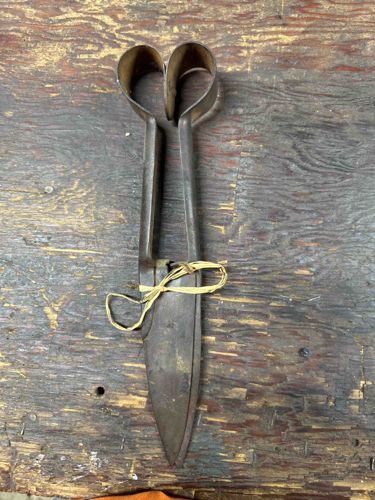
Antique Sheep Shears
This appears to be a pair of antique sheep shears, an agricultural tool used for shearing wool from sheep. The shears are constructed entirely of metal, likely hand-forged iron or steel, given their robust and somewhat unrefined appearance. They feature a distinctive 'spring-back' design, where the two blades are joined at the pivot point and the handles form a single spring that keeps the blades open when not under pressure. The handles are shaped into large, elongated loops, designed for the user's hands to grip comfortably, allowing for the repetitive opening and closing action. The metal exhibits a dark, oxidized patina consistent with age and exposure to the elements, suggesting it has not been recently cleaned or polished. There are visible signs of wear, including surface rust, pitting, and scratches, particularly on the blades where they would have encountered wool and other debris. The blades themselves are long and relatively narrow, tapering to a point, and show signs of sharpening over time, indicating practical use. A thin piece of what appears to be raffia or natural fiber twine is tied around the blades, presumably to keep them closed for storage or transport. No discernible maker's marks or signatures are visible in the provided image. The overall craftsmanship suggests a utilitarian, handmade, or early industrial manufacturing process. Based on the construction and style, these shears likely date from the late 19th to early 20th century. The condition, while showing age, appears to be stable with no major breaks or repairs evident, preserving its historical integrity.
AI-Generated Appraisal Disclaimer
Estimated Value
$40-70
Basic Information
Category
Antique Agricultural Tool
Appraised On
December 7, 2025
Estimated Value
$40-70
Item Description
This appears to be a pair of antique sheep shears, an agricultural tool used for shearing wool from sheep. The shears are constructed entirely of metal, likely hand-forged iron or steel, given their robust and somewhat unrefined appearance. They feature a distinctive 'spring-back' design, where the two blades are joined at the pivot point and the handles form a single spring that keeps the blades open when not under pressure. The handles are shaped into large, elongated loops, designed for the user's hands to grip comfortably, allowing for the repetitive opening and closing action. The metal exhibits a dark, oxidized patina consistent with age and exposure to the elements, suggesting it has not been recently cleaned or polished. There are visible signs of wear, including surface rust, pitting, and scratches, particularly on the blades where they would have encountered wool and other debris. The blades themselves are long and relatively narrow, tapering to a point, and show signs of sharpening over time, indicating practical use. A thin piece of what appears to be raffia or natural fiber twine is tied around the blades, presumably to keep them closed for storage or transport. No discernible maker's marks or signatures are visible in the provided image. The overall craftsmanship suggests a utilitarian, handmade, or early industrial manufacturing process. Based on the construction and style, these shears likely date from the late 19th to early 20th century. The condition, while showing age, appears to be stable with no major breaks or repairs evident, preserving its historical integrity.
Related Tags
Get Your Items Appraised
Instant estimates of your treasures with AI-powered instant appraisals